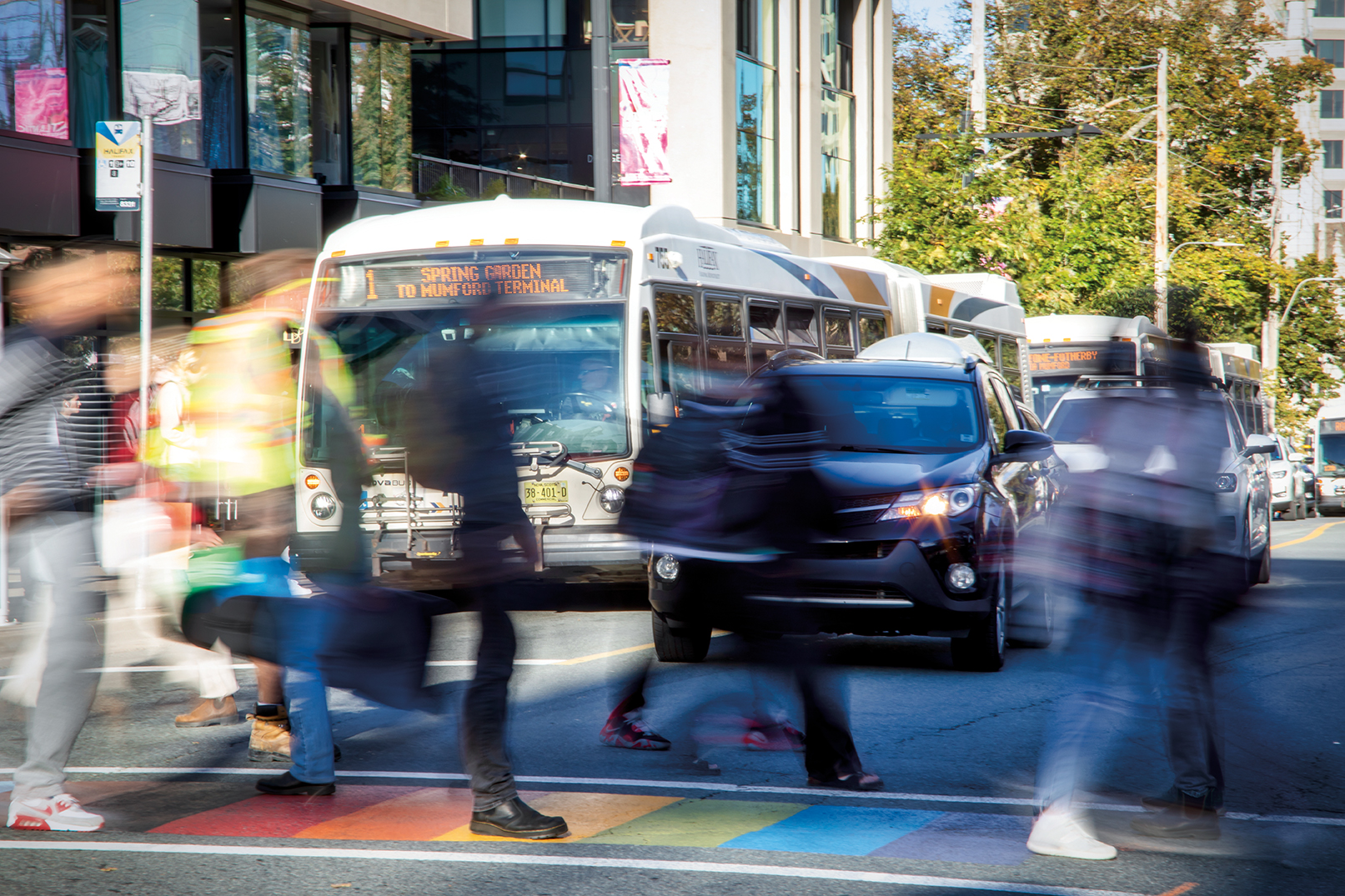‘It’s not rocket science’

Photo: Bruce Murray
What has Halifax learned from a summer attempt to transform Spring Garden Road?
It’s a sunny, late morning on Spring Garden Road. Vehicles stopped at a red light clog up the narrow street. A car with hazard lights flashing is parked on the sidewalk, while a driver blows their horn at a pedestrian using a crosswalk.
It wasn’t supposed to be this way.
On July 4 of this year, Halifax closed four blocks of Spring Garden Road to cars: South Park Street to Queen Street, from 7 a.m. to 8 p.m. daily. The goal was to move buses along the street faster, and “vastly improve the quality of the experience” for pedestrians, according to Waye Mason, the councillor for South End Halifax, whose district includes that Spring Garden stretch.
It was a pilot project meant to last a year. It lasted four days.
Sara Kirk remembers being “excited” the day the pilot launched. A professor of health promotion at Dalhousie University, she’s also a long-time active transportation advocate who loves biking. Although Spring Garden is near her office, Kirk says she generally avoids the street “because it’s noisy and generally unsafe; you never know if drivers are going to stop when you cross.”
But on July 4, she biked over. “I went to the mall down there and bought some stuff, and I was thinking ‘It’s not too bad, but there are still cars.’ But the next day, there were more cars. There were more the day after that,” she recalls. “Then it was a free-for-all.”
By the end of the week, the city shut the pilot down.
The Spring Garden pilot was supposed to be part of a longer-term transformation, turning part of the street into a car-free corridor. HRM had already banned parking on a stretch of Spring Garden, and narrowed the roadway to eight metres, in part to discourage speeding. Expanded sidewalks and planters with trees and flowers contributed to making the street appear more pedestrian-friendly.
Spring Garden is one of the city’s key choke points for bus traffic. The street is too narrow for bike or bus lanes, so banning cars during peak hours would let the 800 buses a day zip through faster. At the same time, the lack of cars, along with the new street features, would encourage pedestrians to linger.
Planners deemed that shutting Spring Garden to all traffic, including buses, wasn’t practical, hence the transit pilot project.
The signs the city put up to inform drivers of the changes were ineffective. Drivers paid little attention to them and simply carried on down the road. A banner HRM had planned to install above the street didn’t even arrive until after it aborted the project. Police on the scene were unable or unwilling to enforce the new rules.
Although she is disappointed, Kirk is not surprised the pilot failed so spectacularly. Drivers kept going down the street because there was little to indicate they shouldn’t.
“Knowing what we know about human behaviour, and driver behaviour is human behaviour, if there is a road, you’re going to drive down it,” Kirk says. “You have to physically prevent cars from going down the street to actually make it work.”

In a classic bit of understatement, municipal transportation planning manager Mike Connors told a Sept. 14 meeting that “traffic restrictions on Spring Garden Road for the pilot are more difficult to communicate to drivers than we had originally expected. It is now clear that a more robust traffic control plan will be required.”
Urban designer Ken Greenberg agrees. “Literally, you block off the street so nobody can drive through. You can’t have cones that people can drive around,” says Greenberg, who has served as an adviser to many cities in Canada, the U.S., and Europe, and who used to work for the city of Toronto.
“After several generations in which we really catered to the car almost completely, cities around the world are starting to take back space,” he says. But for projects that take space away from drivers to succeed and become permanent, “there has to be some kind of payoff. Something that is attractive, enjoyable, interesting. Otherwise, it’s just perceived as an annoyance.”
HRM staff chose to close off Spring Garden to cars during the hours when vehicle traffic was heaviest. “What was supposed to happen between 7 a.m. and 8 p.m.?” Greenberg says. “Did they expect business owners to put out tables and chairs and then take them back in? Were there arts and culture events?”
Part of the payoff would have been buses that run on time. “The transit system is more attractive to users when it is reliable and frequent,” Mason says. But that’s not a benefit people see right away.
In June 2022, before the pilot launched, Spring Garden Area Business Association executive director Sue Uteck tweeted that some of her members were “cautiously optimistic” while others were “downright dreading” the project.
Uteck says Spring Garden business owners are “evenly split” on making part of the street car-free. With the rise of destinations like Dartmouth Crossing and online shopping, the street draws fewer visitors travelling from afar. Most people coming to work or shop live nearby, and arrive by foot or bike, or take transit.
Like Kirk, she was unimpressed with the pilot’s implementation.
“It’s like (HRM staff) didn’t think through how this was going to happen,” she says. Uteck pointed to the poor signage as a major problem, and says the city underestimated the “Haligonian mindset that we want our car, and we want to park right outside.”
For months after the pilot shut down, there was little word about follow-up, leading to speculation that the project was dead. Two months later, planners told councillors they want to take another shot. They did not give a firm date, but said they hoped to relaunch in spring, this time with some kind of physical barriers in place.
One option is automated gates that would only open to authorized vehicles, like buses, emergency vehicles, and garbage trucks. Connors points to a similar setup in Banff, which has been running for three years. Uteck is skeptical, saying the town only sees 200 buses a day, compared to Spring Garden’s 800.
Connors says that signage, on side streets in particular, needs to be clearer. “Drivers tend to respond better when you tell them what not to do, rather than what they should do.” And everyone agrees relying on cops to wave off drivers isn’t a good use of police time.
Connors told the meeting that “this is a unique pilot project, and there isn’t a design guide or rulebook that we look to, nor really any directly relevant examples from other places.”
That would be news to Kirk, who spent part of her summer visiting pedestrian-and-bike-friendly cities in Europe. “Certainly, other places have figured this out. It’s not rocket science,” she says, pointing to Margaret Island in Hungary’s capital Budapest, where gates open for buses and taxis with a transponder. Then there’s Bratislava, Slovakia, which she describes as “quite like Halifax in some ways: A very old city that’s got lots of hills and cobbled streets.” Red lights make it clear cars aren’t welcome on some of those streets, and much local delivery is done by cargo bike.
Such an endeavour might be too costly for a pilot project, HRM staff say reprogramming traffic lights could cost hundreds of thousands of dollars, but transforming a city requires big steps.
Haligonians like to rebut that such ideas are fine for Europe, but Halifax isn’t Amsterdam.
The thing is though, Amsterdam wasn’t always Amsterdam either. In a 1972 TV documentary on the city’s De Pijp neighbourhood, children fought to close local streets to traffic, so they could have a place to play. Adults chipped in to help. In one dramatic scene, the owner of a white van leapt out of his vehicle to toss aside a makeshift barrier. A safe streets activist replaced the barrier. This repeated a few times, until the enraged driver attacked the activist.
In another scene, we see a discussion of measures Halifax has only recently begun considering: lowering speed limits to 30 km/h, using one-way streets to direct traffic away from certain areas, and shutting streets to car traffic. Remember: this was filmed 50 years ago.
The pessimistic view is that the Spring Garden pilot simply can’t work. The optimistic view is it was poorly implemented, and design fixes can get it right.
That’s Mason’s belief.
He leans towards making the four-block section of the street car-free around the clock, and says the fact that there are far fewer buses in the evening would “basically make it a pedestrian street. It would transform Spring Garden Road if we made it 24 hours.” Mason says half the businesses in the area would likely be in favour of this approach, and half “will think it’s the end of the world.”
Uteck says the suggestion “absolutely will not work.”
As for the failure of the pilot, Mason says that’s the nature of pilots, and not a reason to give up. “It was embarrassing and sad it only lasted four days, and I wish the staff-directed implementation of the signs had been different,” he says. “But when you do a pilot, you’re trying something to learn from it, and you’re accepting there’s a risk of failure.”
Greenberg also takes the long view: “You have to bear in mind, even in Amsterdam, even in Copenhagen, the cities that have come so far in the direction of moving from vehicles to active transportation, they all went through those struggles too. It’s a sequential process.”















